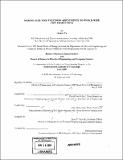Making real-time precision adjustments to world-wide chip production
Author(s)
Pai, Neelesh G
DownloadFull printable version (52.98Mb)
Other Contributors
Leaders for Manufacturing Program.
Advisor
David Simchi-Levi and Don Rosenfield.
Terms of use
Metadata
Show full item recordAbstract
Intel has recently embarked on a mission to improve its supply chain responsiveness. Currently production lead times are around 4 months requiring a forecast a quarter out. Most customer demand changes happen within lead time since customers only know their demand a few weeks before shipment. While stable production plans help maintain factory utilization rates their inflexibility can also lead to missed revenue opportunities or unneeded inventory. The challenge then is to make planning processes agile enough to react to late demand changes. The FAB has a 2-3 month throughput time or latency. The subsequent Assembly-Test (ATM) operation has a 1-2 month latency. Increasing competition requires the striking of a balance between competitive service levels and excess inventory. This Thesis looks to develop ways of making more real-time tactical demand updates to production plans used by the global factory network to improve Supply Chain Responsiveness. Using business analytics and organizational processes analysis, ways of making late demand changes to the production plan are evaluated. The project focuses on Intel's global ATM network due to its proximity to end customer demand. A holistic solution to use available intelligence is proposed. The focus is on creating data visibility across the supply chain and on putting feedback loops in planning processes to intercept planning processes at various points with new information as and when it becomes available. (cont.) Issues examined include demand signal generation, the choice of different demand signals, solver algorithms to convert demand inputs to a global production plan, inventory target setting and implementation in production plan and finally ATM processes such as SDD (delayed product differentiation at the semi-finished goods warehouse) for Product Mix and volume determination. The hypothesis is that this will lead to a better understanding of the interaction between various planning processes.
Description
Thesis (M.B.A.)--Massachusetts Institute of Technology, Sloan School of Management; and, (S.M.)--Massachusetts Institute of Technology, Dept. of Electrical Engineering and Computer Science; in conjunction with the Leaders for Manufacturing Program at MIT, 2009. Includes bibliographical references (p. 94-95).
Date issued
2009Department
Leaders for Manufacturing Program at MIT; Massachusetts Institute of Technology. Department of Electrical Engineering and Computer Science; Sloan School of ManagementPublisher
Massachusetts Institute of Technology
Keywords
Sloan School of Management., Electrical Engineering and Computer Science., Leaders for Manufacturing Program.